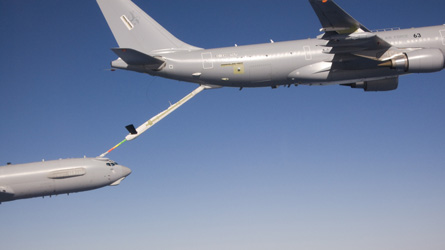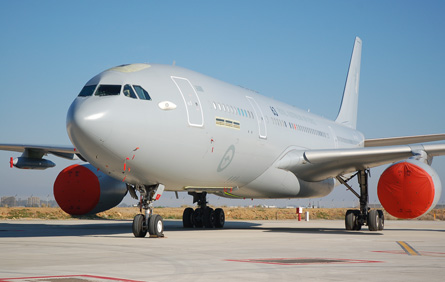The Royal Australian Air Force's first Airbus A330-based multirole tanker/transport has for the first time passed fuel to another large aircraft, moving the type closer to its delayed service entry late this year.
One of five RAAF-designated KC-30As on order, the modified airliner transferred almost 30t of fuel from its centreline boom to a French air force Boeing E-3F airborne warning and control system aircraft during two test flights conducted from Airbus Military's Getafe site near Madrid.
"This is a significant milestone in the programme," says Antonio Caramazana, vice-president and head of Airbus Military Derivatives. "The E-3 AWACS is a challenge because of its aerodynamics characteristics due to the large radome. The AWACS crew reported that the handling of the aircraft was very smooth during the refuelling operation." This was conducted at an altitude of around 20,000ft [6,100m] and at 250kt [460km/h], says Airbus.
 |
|---|
© Airbus Military |
Australia plans to accept its first two KC-30As in the fourth quarter of this year, with initial clearances being sought to refuel Boeing F/A-18A fighters and other KC-30As. The other three should follow in 2011-12, says Todd Russell, Madrid-based project team leader for its Defence Materiel Organisation.
The RAAF also wants its new tankers to progressively support operations with the F/A-18F Super Hornet, BAE Systems Hawk 127 advanced jet trainer, Boeing C-17 strategic transport and 737-based Wedgetail airborne early warning and control system aircraft, and eventually with the Lockheed Martin F-35 Joint Strike Fighter, he says.
Challenges facing the service's introduction of the KC-30A include maintaining air-to-air refuelling skills after having retired its last Boeing 707 in June 2008, and using a boom for the first time, Russell told IQPC's Air Tankers and Aerial Refuelling conference in London on 25 January. A training lag also exists because simulators for the new type will not be delivered until the first quarter of 2011, he says.
Meanwhile, the RAAF is also "having difficulties with defining the UARRSI [universal aerial refuelling receptacle slipway installation] clearance envelope," says Russell. Three of its aircraft are being equipped with boom-mounted instrumentation to support the work, he adds.
In addition to providing AAR services, Australia's KC-30As are also being configured to carry 272 passengers and below-deck freight.
 |
|---|
© Craig Hoyle/Flight International |
Russell also told the conference that Australia is proposing the formation a joint user group for air forces equipped with Airbus-derivative tankers. This would enable the partners to share operational lessons and discuss maintenance, certification and technical issues. The forum could also lead to agreements to "collaborate on software and hardware upgrades", he believes.
The joint user group proposal is being made to other A330 MRTT buyers Saudi Arabia, the UK and the United Arab Emirates, and to A310 tanker operators Canada and Germany. The A330 is also a candidate to meet requirements in nations including France, India and the USA.
Source: Flight International























